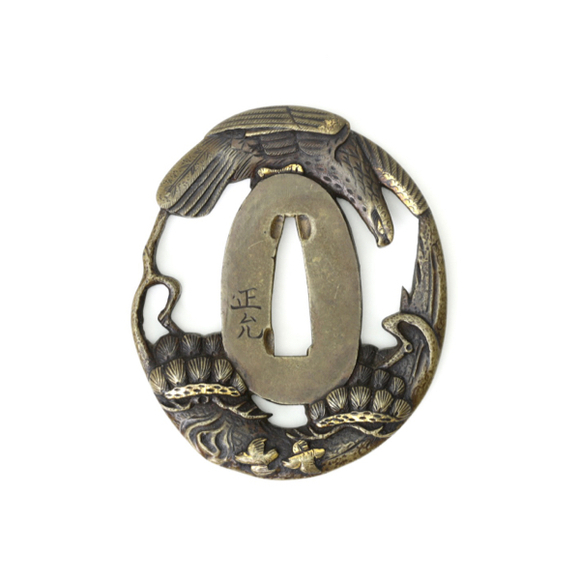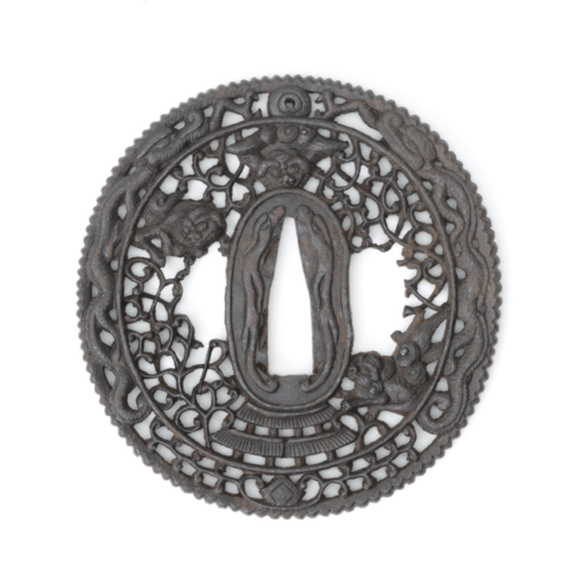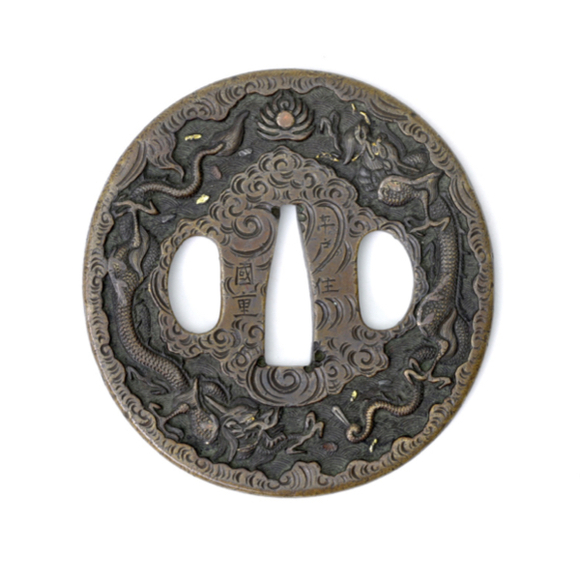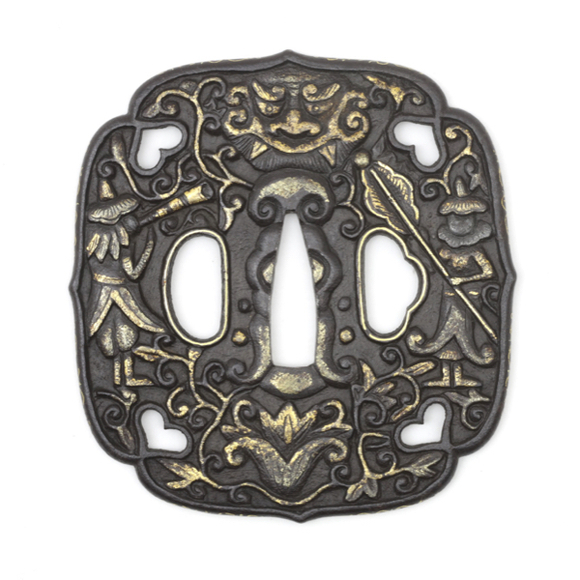Russet iron, one-piece construction with decorative grooves.

Nagasa 65.2 cm
(blade length)
Sori 2.8 cm
(curvature)
Motohaba 2.9 cm
(width at base)
Sakihaba 1.9 cm
(width at kissaki)
Kissaki 3.2 cm
(point length)
Nakago nagasa 14.8 cm
(tang length)
Nakago sori -2 mm
(tang curvature)
N.B.T.H.K. Hozon
Issued September 2008.
Ubu, one mekugi ana
Signed:
備州長船祐定
Bishū Osafune Sukesada
大永三年八月日
Daiei 3rd year 8th month
(August 1523)
580 grams
19 cm from base of blade
(unmounted)
Sue-Bizen
Osafune village, Bizen province, Japan
Made in August 1523
Imported from Japan
Introduction
The Muromachi period was a period of intense civil war in Japan. Bizen and Mino provinces were the main sword production centers during this period, and most focused on making large quantities of mass-produced swords for the war efforts. During this time, the uchigatana, optimized for single-handed use, replaced the long tachi. The uchigatana is the predecessor of the later katana, which had a longer grip that could also be used with two hands.
This period is not known for its high-quality swords. Both Bizen and Mino made large quantities of tabagatana (束刀), "bundled swords" to supply the armies. One of the most prolific workshops was a group in the village Osafune in Bizen who signed their works with Sukesada.
There were some exceptions, though. Yosozaemon Sukesada (1466-1542) of Osafune was an extremely skillful smith and one of the best of the Sukesadas. He was mainly active in the first decades of the 16th century and is thought to have pioneered the so-called kani no tsume (蟹の爪), “crab claws” in the hamon (temperline), but was known to work in both suguha (straight hamon) and flamboyant, hitatsura style full tempering as well. His best art swords, signed with the personal name Yosozaemon, command six-figure prices on the collector market. See, for example, an excellent specimen sold by Darcy Brockbank that was later published in the Nihonto Shubi by Tanobe Michihiro.
Fujishiro Matsuo rated his works sai jō saku (最上作), the highest possible classification reserved for grandmasters, and professional test cutter Yamada Asaemon V ranked Yosozaemon's swords as ō-wazamono for extreme sharpness.
But Yosozaemon did not only make high-end art swords; a considerable portion of his production consisted of practical fighting pieces. After all, it was still war.
Read more in the Sukesada glossary entries.
This sword
A Bizen Osafune Sukesada uchigatana. It is signed with the short signature found on mass-produced swords from the Sukesada workshops in Osafune:
備州長船祐定
Bishū Osafune Sukesada
大永三年八月日
Daiei 3rd year 8th month
(August 1523)
The sword is, however attributed to the grandmaster Yosozaemon Sukesada himself by no less than Dr. Honma Junji, co-founder and chairman of the NBTHK. The sayagaki (writing on the scabbard) by his hand reads:
備前国長船与三左衛門尉祐定
Bizen kuni Osafune Yosōzaemon jo Sukesada
"Osafune Yosōzaemon no Jō Sukesada from Bizen province"
大永三年紀
Daiei sannen-ki
"3rd year of Daiei" (1523 A.D.)
刄⻑二尺一寸三分
Hachō ni-shaku issun san-bu
"Blade length ~ 64.5 cm"
昭和甲子年秋 薫山誌「花押」
Shōwa kinoe-nezumidoshi aki
Kunzan shirusu + kaō
"Written by Kunzan [Honma Junji] in fall of the year of the rat of the Shōwa era"
(1984) + monogram
(Sayagaki translation and authentication by
Markus Sesko)
Blade
It has the typical Bizen sori (curvature), with a curve concentrated around the "waist" of the sword, near the hilt. It reminds of the koshizori (waist curvature) of the majestic tachi of the Kamakura period (1192-1333), the "golden age" of Japanese sword making. It has a pronounced funbari (tapering in width) mostly associated with earlier swords, and the smaller kissaki (tip section), both elements more pronounced than normally seen in this era.
The steel is a tightly forged itame (wood grain) with intricate mokume (burl wood grain) tending towards a masame (straight wood grain) near the edge.

Section of blade showing the hada.
The hamon (temperline) is a nioi-based koshi-no-hiraita midare (wavy hamon that widens near the base) with kani no tsume (蟹の爪), “crab claws”. Some streaks of nie are seen, faint utsuri and some instances of sunagashi (brushed sand-like patterns), and ha-hada (forging patterns visible in the hardened edge).

The same section of blade, light angled to show the hamon.

Crab claw hamon seen at an angle with gleaming light.
The best way to enjoy a temperline.
The boshi (hamon at tip) is a continuation of the undulating hamon, is slightly different on each side as is pretty much the norm with Bizen Sukesada work.
Nakago (tang)
The nakago is ubu (unshortened) and with four mekugi-ana (holes for the peg that holds the hilt). It has the somewhat unusual feature of being slightly forward inclined, instead of going along with the blade's curvature.

Conclusion
Attributed to Yosōzaemon Sukesada by no less than Honma sensei. He probably went by a combination of the date on the tang, the better-than-average overall work such as the tightness of forging, and the early appearance of the signature crab claw hamon that Yosōzaemon is believed to have pioneered, which would later be copied by many.
It is perhaps made by a master, it is not a masterpiece and clearly not one of Yosōzaemon's famed art swords. It is a purely practical fighting piece, but not one without attention to detail. The interplay between the dense mokume hada and the hamon is pleasing, and perhaps betrays a Yosōzaemon that couldn't help to be a little artistic, even when producing in bulk.
All activities in the hada and hamon are nicely visible by the excellent polish the piece is in. It is in very good shape, considering it will be 500 years old by August 2023.























Unusual tsuba with foreign figures and Chinese auspicious symbols.






